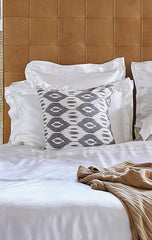Silk pillowcase vs Satin Pillowcase
How can you tell silk from satin?
Simply put, silk is produced by silkworms, whereas satin is a manmade fabric created using a specific type of weave. Most types of satin are made from polyester; however, you can also get what’s known as ‘silk satin’ – satin that is made from silk fibres. The majority of satin pillowcases – particularly the ones at lower price points – will be made from synthetic fabrics, as they’re a lot cheaper to manufacture. Aside from the product information, there are ways to tell the difference between silk and satin. The easiest way is to feel the fabric for yourself. Silk has a much softer, smoother feel, whereas satin is slightly rougher to the touch.The Pros & Cons of Silk and Satin Pillowcases
If you’re deciding between a silk or satin pillowcase for your bedroom, you may be wondering what the pros and cons are of each type of material. Satin pillowcases are often significantly cheaper than their silk counterparts. Another benefit with satin is that it’s far easier to take care of – simply machine wash as you normally would cotton or jersey. In contrast, silk pillowcases cost significantly more to buy and require more specialist care when it comes to washing. That said, silk has some amazing properties that satin does not. As it’s a natural fibre, it offers benefits to the skin due to its similar chemical composition. Silk is also naturally hypoallergenic, which means it repels common household allergens like bacteria and dust mites. As such, silk is the material chosen by luxury spas and hotels around the globe.
Is satin or silk better for skin?
While both materials offer a cool and comfortable sleeping environment, silk is far better for the skin. Silk is smoother and has a rich amount of nutrients contained within its fibres. The amino acids found in silk fibres are essential for the human body and help to boost lost collagen from the skin. The hydrating benefits of silk also help to keep the skin at just the right level of humidity, too. Silk also has fantastic insulation properties, helping to keep the temperature around the skin at the right level, allowing the skin to regenerate during the night. It is also suggested that silk pillowcases can help to reduce wrinkles as skin is less likely to crease while sleeping.Is satin or silk better for hair?
While both materials are better for hair than regular cotton, silk is considered the better material of the two. This is because of its natural fibres when compared to satin, which does not boast these same qualities. Opting for silk or satin is much better for hair, especially if you have naturally wavy, curly or afro tresses. This is because both materials help to reduce frizz while maintaining moisture.Do satin pillowcases work as well as silk?
Both satin and silk pillowcases offer a cool, comfortable sleep, and are great alternatives to regular cotton and jersey. If you’re looking for a pillowcase that will help care for your skin and hair, silk is the better choice, if your budget allows. If you’re looking for a quality, luxurious silk pillowcase, at Gingerlily we specialise in the most delicate, A Grade mulberry silk pillowcases and bed linen. Our range of expertly crafted silk pillowcases and bed linens provide a rejuvenating sleep experience.

The Gingerlily Beauty Box Mulberry Silk Pillowcase is one of our bestsellers and is the perfect product for a newcomer to silk. It’s recommended by leading dermatologists for its anti-ageing properties and helps to keep skin soft, supple and wrinkle-free. These pillowcases contain the same natural fibres found in our skin and hair, helping to reduce friction and moisture loss while keeping hair healthy, sleek and shiny.


